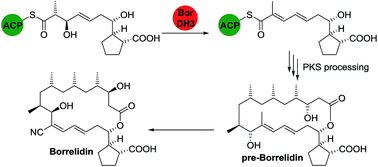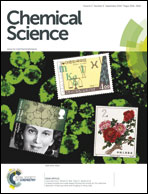Uncovering the origin of Z-configured double bonds in polyketides: intermediate E-double bond formation during borrelidin biosynthesis†
Abstract
Formation of Z-configured double bonds in reduced polyketides is uncommon and their origins have not been extensively studied. To investigate the origin of the Z-configured double bond in the macrolide borrelidin, the recombinant dehydratase domains BorDH2 and BorDH3 were assayed with a synthetic analogue of the predicted tetraketide substrate. The configuration of the dehydrated products was determined to be E in both cases by comparison to synthetic standards. Detailed NMR spectroscopic analysis of the biosynthetic intermediate pre-borrelidin confirmed the E,E-configuration of the full-length polyketide synthase product. In contrast to a previously-proposed hypothesis, our results show that in this case the Z-configured double bond is not formed via dehydration from a 3 L-configured precursor, but rather as the result of a later isomerization process.


 Please wait while we load your content...
Please wait while we load your content...